Diplomatic Bluebook 2017
Chapter 2
Japan's Foreign Policy that Takes a Panoramic Perspective of the World Map
2.Situation in Latin America and the Caribbean Region
(1) Political situation
In 2016, presidential or general elections were held in Jamaica, Peru, Dominican Republic, Saint Lucia, Nicaragua, and Haiti. In Jamaica, the opposition party, Jamaica Labour Party won and party leader Andrew Holness became prime minister; in Peru Pedro Pablo Kuczynski narrowly defeated candidate Keiko Fujimori to win the election. In the Dominican Republic, President Danilo Medina won re-election, and in Saint Lucia there was a change of government and Prime Minister Allen Chastanet took power.
Furthermore, in March, President Obama became the first sitting U.S. president to visit Cuba in 88 years, which has become a turning point in the history of confrontation that had lasted since the Cuban revolution in 1959. On the other hand, Fidel Castro, the leader of the Cuban revolution and the former President of the Council of State of the Republic of Cuba passed away in November, and dignitaries from approximately 60 countries around the world participated in the ceremony held in the capital Havana. In August, immediately after the closing of the Rio de Janeiro Olympics in Brazil, the impeachment of President Dilma Rousseff was established on the grounds of her liability for fraudulent manipulation of the national budget. In Colombia, the peace negotiations the government started with the Revolutionary Armed Forces of Colombia (FARC) in 2012 reached a final agreement and a peace accord was approved by the Congress in November.
As regional integration organizations, the 4th Community of Latin American and Caribbean States (CELAC) Summit Meeting (in Ecuador) in January, the 7th Association of Caribbean States (ACS) Summit Meeting (in Cuba) and 46th Organization of American States (OAS) General Assembly (in the Dominican Republic) in June, and the CARICOM Summit Meeting (in Guyana) in July were held.
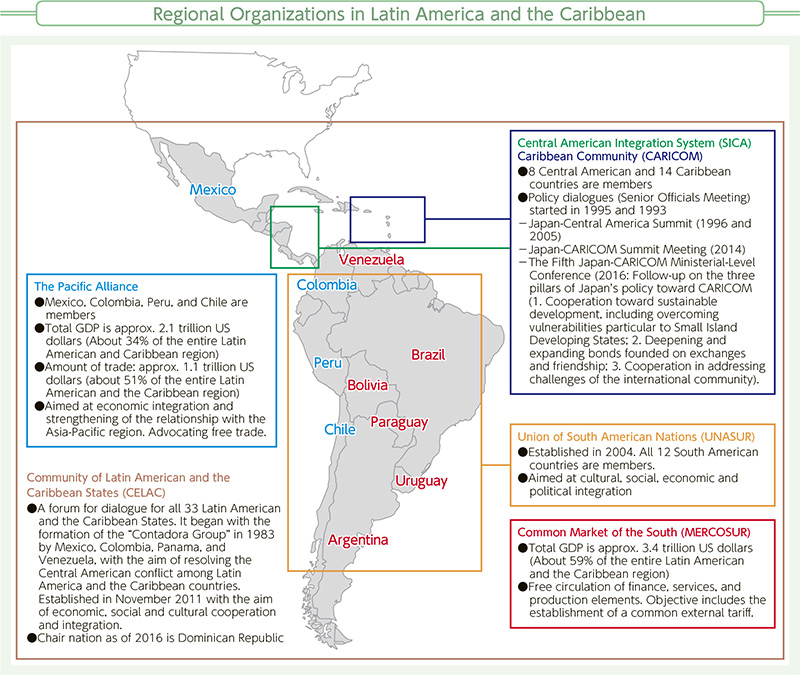
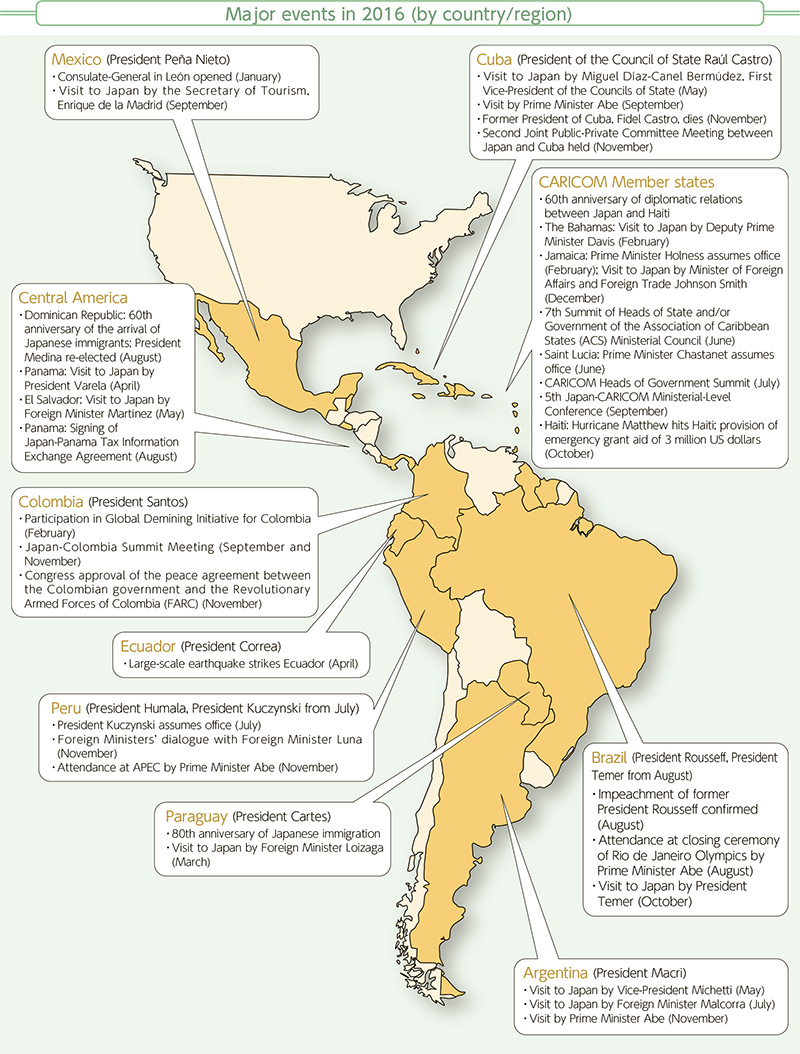
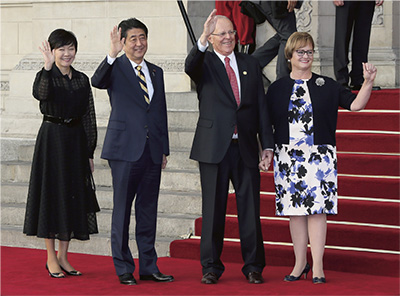 Visit by Prime Minister Abe to Peru (November 18, Peru; Photo: Cabinet Public Relations Office)
Visit by Prime Minister Abe to Peru (November 18, Peru; Photo: Cabinet Public Relations Office)(2) Economic conditions
The economic growth rate of the entire region was minus 0.7% in 2016 (estimated by the International Monetary Fund (IMF); hereinafter the same). In particular, due to falling commodity prices and political corruption, in recent years, countries that economically depend on commodity products such as crude oil or mineral resources continue to face severe economic circumstances. Specifically, the economic growth of Brazil, which boasts the largest economy in the region, was minus 3.5%, a remarkable level of stagnation. Furthermore, Venezuela, which has maintained a state-managed economy since the era of the Hugo Chávez administration, is in a severe situation, with economic growth forecast to be minus 10% and the inflation rate forecast to be approximately 480%.
On the other hand, in Mexico, a member of the G20 to which a remarkable number of companies are entering from Japan, the economic growth rate is forecast to remain strong at 2.2% continuing on from last year. In addition some countries, particularly in Central America, are forecast to record notable economic growth rates such as 5.9% in the Dominican Republic, 5.2% in Panama, 4.5% in Nicaragua, 4.3% in Costa Rica.
Latin America and the Caribbean region is a major global food and natural resources supply area. In particular, regarding food it is a major producer of coffee beans, oranges, soy beans, salmon, corn, etc., and regarding natural resources, in addition to silver, copper, zinc, iron ore, oil, etc., the region is a major producer of rare metals such as lithium, molybdenum, and rhenium, the demand for which is increasing. In recent years, Argentina, the world's 2nd largest shale gas possible reserves and Mexico, the world's 6th largest possible reserves, are attracting attention as the sites of major reserves of shale gas. Furthermore, in June the Panama Canal was expanded and the passage of liquefied natural gas (LNG) carriers became possible, so increased use of LNG carriers going forward is forecast.
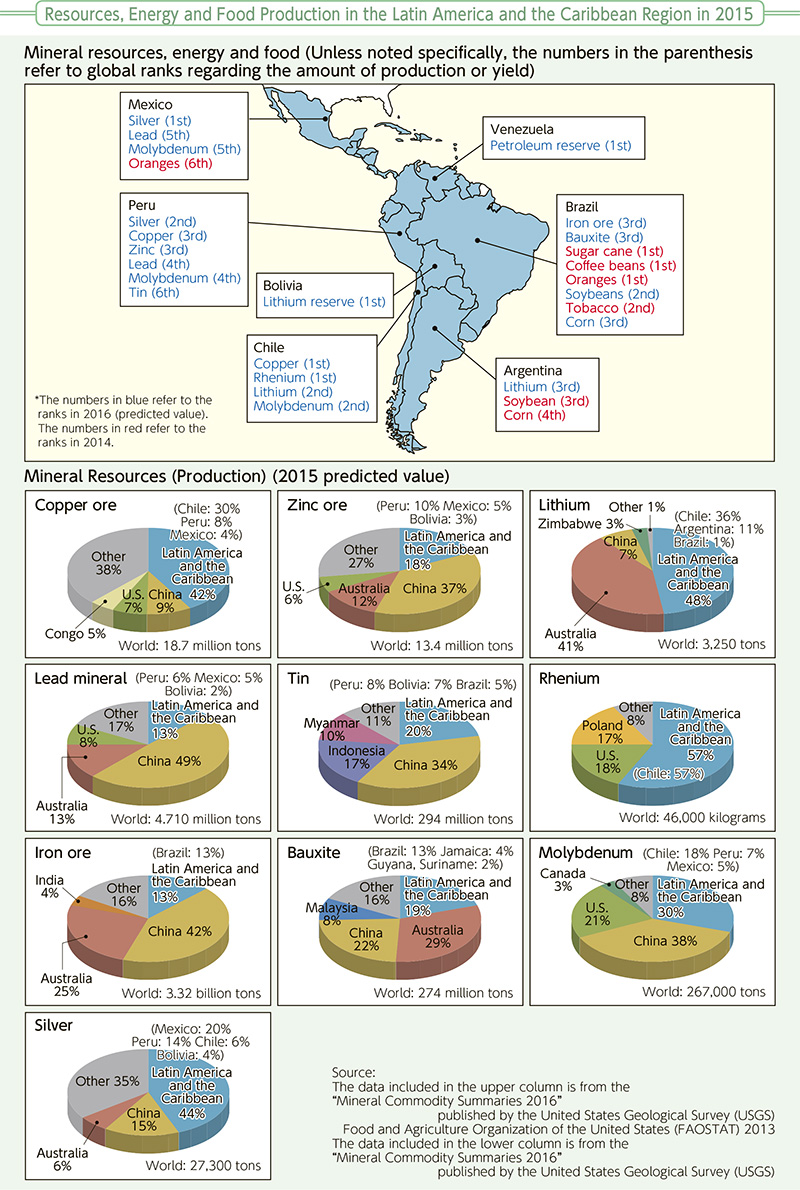
Latin America and the Caribbean have the largest Nikkei communities overseas, which consist of approximately 2,130,000 Japanese immigrants and descendants in the world. “Nikkei” refers to Japanese people who moved their home from Japan and are living overseas with the objective of living there permanently, and their descendants. More than 100 years have passed since Japanese people started immigrating to Latin America and the Caribbean. During that time, Nikkeis have been active in all fields, made contributions to their local communities, and obtained the trust of each country due to their diligent and honest characters. As a result, the presence of Nikkei is the foundation of the goodwill, trust, and high evaluation of the Latin American and the Caribbean countries towards Japan. Furthermore, Nikkeis have made strong efforts to disseminate Japanese culture in the countries in which they are living, and even today they are playing an important role as a bridge between Japan and the Latin America and the Caribbean countries.
On the other hand, more than 100 years of history have passed, and today third, fourth, and later generations are the main actors at the heart of Japanese communities. For this reason, their ties with the traditional Nikkei organizations that supported Japanese immigrants and descendants from the early days are becoming weak, and a new generation that have little awareness of Japanese descendants is emerging. At the same time, a new trend is emerging among young generation such as connecting with each other across regions and countries through social networking services and events, etc. Strengthening of collaboration with Japanese descendants, including this new generation, is becoming increasingly important in Japan's strengthening of relations with Latin America and the Caribbean.
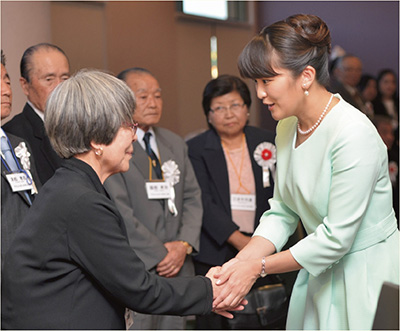 Her Imperial Highness Princess Mako of Akishino deepening relations with Nikkeis throughout Paraguay (September 9, Paraguay; Photo: La Federación de Asociaciones Japonesas en el Paraguay)
Her Imperial Highness Princess Mako of Akishino deepening relations with Nikkeis throughout Paraguay (September 9, Paraguay; Photo: La Federación de Asociaciones Japonesas en el Paraguay)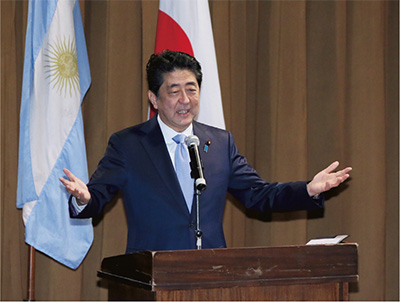 Prime Minister Abe making a speech at an exchange event with Nikkei (November 21, Argentina; Photo: Cabinet Public Relations Office)
Prime Minister Abe making a speech at an exchange event with Nikkei (November 21, Argentina; Photo: Cabinet Public Relations Office)The year 2016 marked the 80th anniversary of Japanese immigration to Paraguay. Her Imperial Highness Princess Mako of Akishino visited Paraguay from September 7 to September 14. Her Imperial Highness attended the ceremony to commemorate the 80th anniversary of Japanese immigration to Paraguay, and had opportunities for interactions with Nikkeis of wide range of generations in Asuncion, the capital of Paraguay, and Japanese colonies in regions.
Furthermore, in November the same year, Prime Minister Abe gave a speech in Argentina calling for collaboration with Nikkei in Latin America and the Caribbean. Prime Minister Abe expressed respect and gratitude for the contributions of the Nikkeis to date, and declared Japan's support for the cultural and sports activities of Nikkeis across borders and that approximately 1,000 Japanese descendants would be invited to Japan over the next five years. Prime Minister Abe concluded his speech by saying “I too will make every effort to ensure that you all think of Japan with pride. Moreover, I tend to make every effort to support you all so that you can achieve even more in the regions in which you live.” He received thunderous applause from the crowd of 920 people at the gathering. It is expected that collaboration with Japanese descendants in Latin America and the Caribbean will be further strengthened through this visit.
“We hope to build world's fastest machine.” - over 30 small factories have put together the strength in manufacturing that they have cultivated over the years to take on the world.
This was one passage in the policy speech by Prime Minister Abe in the 183rd Session of the Diet in February 2013. In Ota Ward, Tokyo, there were craftspeople led by Mr. Junichi Hosogai working feverishly with the aim of becoming the number one in the world with a bobsleigh.
Bobsleigh is still a minor sport and the competition level is not necessarily high in Japan, but in Europe it is one of the popular sports, and famous large companies such as Ferrari, BMW, McLaren, etc. are involved in the development of sleds. “The Shitamachi Bobsleigh Network Project” in Ota Ward was the first company to begin the development of sleds made in Japan.
This project was started in 2011, the first bobsleigh was completed in the following year, and in March 2013 a Japan-made bobsleigh made its debut in an international competition. In June of the same year, the Shitamachi Bobsleigh Limited Liability Company was established, and it has continued to constantly make progress. For example, it was certified as a Japan Brand Development Assistance Program.
However, it has not always been an easy road to travel. In November 2013 the Japan Bobsleigh, Luge and Skeleton Federation gave notice that the Shitamachi bobsleigh would not be used in the Sochi Winter Olympic Games the following year and also issued 27 demands for improvements. Subsequently, the company worked hard to meet all the demands for improvement that had been pointed out, but in November 2015 it was announced by the Japan Federation that the Shitamachi bobsleigh would not be used in the Pyeong Chang Winter Olympic Games either. This was a tremendous shock for the craftspeople in Ota Ward. On the other hand, overseas expansion was suggested, and the company directed its efforts toward selling the bobsleigh abroad. One of the countries they approached was Jamaica, which was famous for the movie Cool Runnings.
The passionate ambition of the craftspeople was also transmitted to the diplomats of Japan. In December 2015 Hiromoto Oyama, Counsellor of the Embassy of Japan in Jamaica, happened to meet the president of the Jamaica Bobsleigh Federation taking a break at a cafe with his family in the afternoon of the day before going on an overseas business trip, and started talking about the bobsleigh. The president was very receptive and expressed an extremely positive attitude regarding use of the Japan-made bobsleigh. It is a result of the daily efforts of the Embassy to build relations. The president gave a favorable response, and the Embassy of Japan in Jamaica came to dedicate its heart and soul to matching Japan's offer and Jamaica's interest.
The enthusiasm of the Japanese craftsman and diplomats bore fruit, and in January 2016 it was finally decided that the Jamaican bobsleigh team would use the Shitamachi bobsleigh. The sleds are loaded with the Japanese spirit, aiming to become the world champion, and are continuing to progress even today, targeting the 2018 Pyeong Chang Winter Olympic Games.
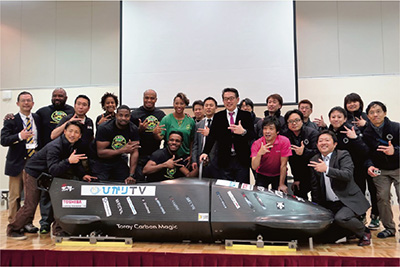 Press conference in the Ota Ward Industrial Plaza (January 14; Photo: Shitamachi Bobsleigh Network Project)
Press conference in the Ota Ward Industrial Plaza (January 14; Photo: Shitamachi Bobsleigh Network Project)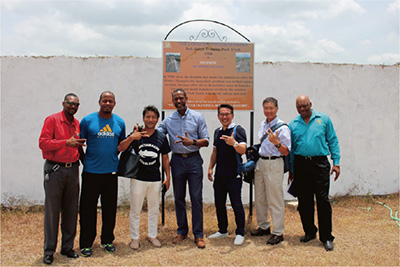 At GC Foster College in Spanish Town, Jamaica. President Chris Stokes (center), Mr. Hosogai, representative of Shitamachi Bobsleigh Limited Liability Company (third from right), and Mr. Oyama Counsellor of the Embassy of Japan in Jamaica (second from right) (July 4)
At GC Foster College in Spanish Town, Jamaica. President Chris Stokes (center), Mr. Hosogai, representative of Shitamachi Bobsleigh Limited Liability Company (third from right), and Mr. Oyama Counsellor of the Embassy of Japan in Jamaica (second from right) (July 4)

